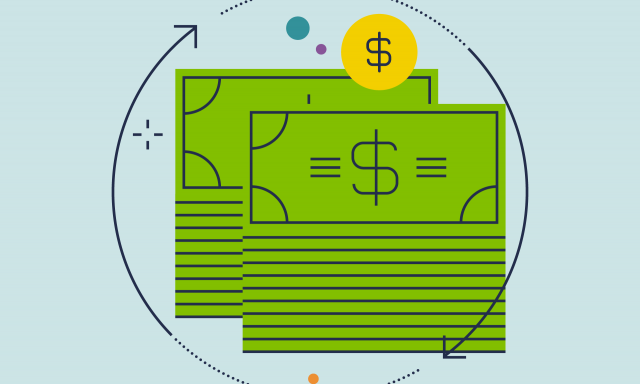

 Article
Article

 Resources are limited, and business and government compete for them … or so goes conventional wisdom and widespread economic theory. Does it hold up in the real world? Professor Dan Murphy’s research, presented at the IMF’s annual research conference, investigates government spending and its effect on the private sector.
Resources are limited, and business and government compete for them … or so goes conventional wisdom and widespread economic theory. Does it hold up in the real world? Professor Dan Murphy’s research, presented at the IMF’s annual research conference, investigates government spending and its effect on the private sector.

Insights from
Written by
Does government spending pull resources away from the private sector?
It’s a question that has long vexed economists.
One widely held theory, the crowding-out effect, asserts that yes, government spending eats up resources that otherwise would be available for businesses.
“The theory would suggest that when the government spends money on battle tanks, that consumes resources that might have been used to make cars,” says Daniel Murphy, a professor in Darden's Global Economies and Markets area.
However, new research shows that crowding out doesn’t necessarily happen, as long as the economy isn’t running at full capacity, producing to its full potential.
“We find no evidence that government spending in an industry/location crowds out income in other local industries or in other locations,” states a recent research study titled “Local Fiscal Multipliers and Fiscal Spillovers in the United States.” Murphy, with co-authors Alan Auerbach and Yuriy Gorodnichenko of the University of California — Berkeley, prepared the paper for the 19th International Monetary Fund Jacques Polak Annual Research Conference.
“These findings are contrary to conventional wisdom and the predictions of neoclassical theory,” the report continues. In part, neoclassical economics focuses on the role of supply, demand, and relative prices of goods or services in the allocation of scarce economic resources. The key to this concept is that resources are limited and always have alternative uses for which businesses and governments compete. But the researchers found that the theory doesn’t reflect what happens in the real world.
To find out whether government defense spending does indeed crowd out the private sector, the trio of academics analyzed a slew of data on U.S. Department of Defense (DOD) contracts. The data included geographic locations of the defense contractors, where the contract work was conducted and the industry of the contractors. Then using the duration of each contract, along with its dollar value, the academics looked at “time-specific measures of DOD outlays.” Put simply: The authors worked out when and where the government spent its cash, plus who received the money.
To get a detailed look, the researchers drilled down to three separate measures.
So back to the overarching question: Does the spending on defense pull resources away from other business activities?
The answer is no. “We find that local industries benefit from all three forms of spending,” the report states.
The analysis finds that a dollar of government spending results in a $1.50 gain across the state; if the DOD spends $100 million by ordering goods from one town, then the entire state economy expands by $150 million.
The caveat: The benefits are concentrated in the town where the money is first spent, and while other towns see economic gains, those dissipate with distance. If the government were to place an order for military vehicles in Cleveland, Ohio, then there might only be a negligible economic gain in Cincinnati, on the other side of the state.
Nevertheless, the researchers were perplexed — the results were all positive. Overall there were no detectable adverse economic consequences of the DOD spending.
“We find no evidence that employment falls in areas or industries that don’t directly receive the spending,” the report states.
For economists, this is something of a mind-bending problem. How was it that military manufacturers upped their production, but non-military manufacturers didn’t see their workers quit? As the report states, “Additional production requires additional labor resources from somewhere.” Conventional wisdom would predict that the extra workers relocate geographically or switch industries.
In this research project, there was no sign such a thing happened.
One explanation is that the economies (workers and/or firms) were not running flat out — they had extra room to produce more goods or provide additional services.
This phenomenon is “excess capacity,” in which actual production is less than the potential amount achievable. For example, a factory may have a usually-idle machine that it keeps for emergencies or use when other machines need repairing. But when demand for products is high, then the bosses decide to get it running anyway and do so using their existing workforce. Essentially, they get more output without needing to hire workers away from other firms. Similarly, unemployed workers could be productive if they could find a job — and defense spending appears to be the catalyst.
The authors cite other studies on excess capacity that corroborate that idea.
Daniel Murphy co-authored “Local Fiscal Multipliers and Fiscal Spillovers in the United States,” presented at the 19th International Monetary Fund Jacques Polak Annual Research Conference, with Alan Auerbach and Yuriy Gorodnichenko, both of the University of California — Berkeley.
An expert in economics and public policy, Murphy researches the nature of consumer demand and its implications for market outcomes. His work addresses international issues and macroeconomics, including the determinants of cross-country price differences, the causes of fluctuations in the price of crude oil and the consequences of asymmetric economic growth.
Prior to joining Darden’s Global Economies and Markets area in 2013, Murphy was a National Hunger Fellow and research associate at the Urban Institute.
B.S., University of Notre Dame; M.A., Ph.D., University of Michigan